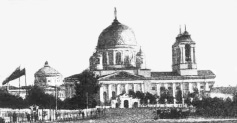
Znamensky temple. (1902)
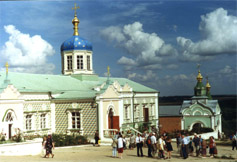
Korennaya Pustyn (2000).
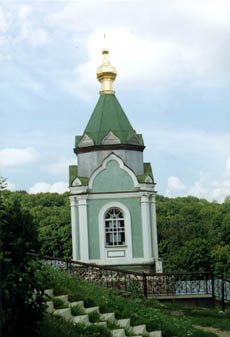
Korennaya Pustyn (2000).
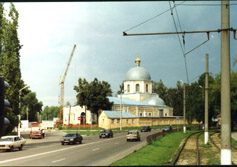
Kursk. The church Vedenskaya. (2000)
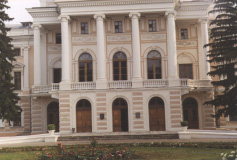
Palace Marino. (1999)
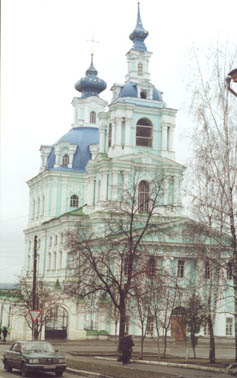
Sergievo-Kasansky temple. (2001)
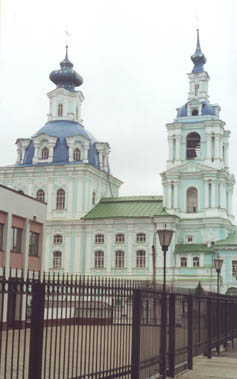
Sergievo-Kasansky temple. (2001)
-
Nicolaevsky
is near Rylsk, founded in 1505
-
Korennaya Rogdestva Bogorodetsi Pustyn (1597)
-
Znamensky
(until 1649 was called Rogdestvensky), begun to build in 1612, finished
in 1615.
- Sviato-Troickiy
- the 1st half of the 17th century.
-
Aleksandro-Mariinskaya obshina is near Shigri (until 1905 was a women
terminal home).
The most famous temples in our region are Znamensky
in Kursk and Korennaya Pustyn in the region.
At those times when Kursk and its region were ruined by
the Tatarsí hordes it seemed that everything declined and would newer recover,
the 8th of September of 1295, in 27 versts (old Russian measure of
distance) of Kursk, in roots of a tree, on the river Tuskar bank there was the
icon of Znameniya Bogomateri found. According the legend, when the icon was
taken from the ground there a source of clean water appeared immediately. The
news of the icon came to the Rylsk prince - Vasily Shemiaka (15th
century) that ordered to bring it to Rylsk. Crowds of people were watching the
arrival of the icon, but the prince refused to meet the icon at the very last
moment. In answer to his action the icon blinded him. Having repented of his
action, V. Shemiaka prayed for mercy and recoveredÖ To thank the icon for his
recovering, the prince built a temple for the holly icon. The temple was named
Rogdestva Bogorodetcy. However, the icon disappeared, in a strange way, from the
temple built in its honor and appeared in the place it had been found. Each time
the icon was taken to Rylsk it returned to the place it had been found.
Therefore, in Korennaya Pustyn, there was a chapel built in which the icon was.
In 1615, after the Polish defeat in Kursk, in honor of that event and to execute
the promise there was a community of monks built. It included 2 wooden churches:
Rogdestva Bogoroditci and holly Mikhaila Malena. B 1618, the icon got a name Znamenie
(Prediction) and was taken to the new built temple Ė Znamensky. In 1631, a
strike of lightning caused the devastating fire that destroyed the temple. In
1634, the renewed temple was completely robbed by the Polish. In 1649, the tsar
Aleksey Mikhailovich ordered to build a stone church named Znameniya Kurskoy
Bogomateri, and the temple got a new name Ė Znamensky. In 1815, the walls of
the Znamenskaya Church were broken because of the foundation weakness, and a
year later there was founded a new cathedral that was finished to build in 1826.
In the 18th century, Korennaya Pustyn was
rebuilt of stone. From 1618, it was occasionally, and from 1726 to 1765, it was
systematically that the icon Znamenie was taken from Znamensky temple to
Korennaya Pustyn for a week. There were the continuous disagreements between
Znamensky temple and Korennaya Pustyn, whose property the icon had to be.
Korennaya community of monks was under the Znamensky temple ruling, but the
solution was not found. In 1767, Synod banned bringing of icon any longer. In
1792, the Sacred procession was renewed in answer of merchantsí requests. The
Sacred procession promoted the fair development. In the order of Synod dated by
the 15th of January of 1806, it was said that in agreement with the
imperator Alexander the 1st the icon Znameniya Bogoroditsi had to be
in Korennaya Rogdestvo-Bogoroditsi temple from the 9th week after the
Easter to the 12th of September. This time Kursk eparchy makes sacred
processions regularly. The best time for Kursk Korennaya fair was in 1852-1853,
when there were goods sold on 11.3 mil. rubles. The biggest quantity of pilgrims
Ė 60,000 was in 1861. There had been several copies of the holly icon made in
different times. They were exhibited in Znamensky temple and in Korennaya Pustyn
during the original had been absent. They took their part in the Crimean War in
1689 and the Patriotic War in 1812. In 1919, the icon appeared in Serbia, where
it was until 1944, then it appeared in Munich, and in 50s it got to the USA.
Now, it is in one of the temples of Russian Orthodox Foreign Church in New York.
In 1989, Russian Ortodocs Foreign Church handed over a copy of the holly icon as
a gift to Korennaya Pustyn.
